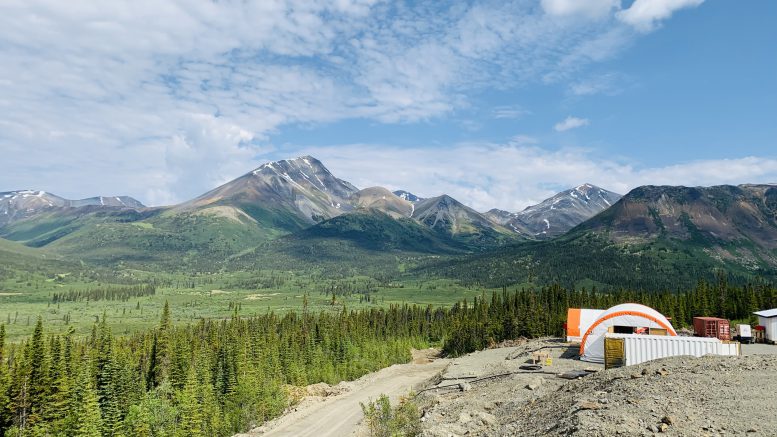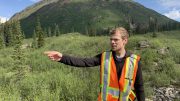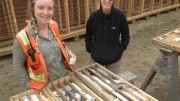Remote eastern Yukon —The snow-peaked mountains and green valleys of eastern Yukon may seem like a place that would attract only wily old prospectors and extreme hikers.
But on a gentle mountain slope, a camp full of young geologists armed with the latest exploration technology are searching for metals needed for the green energy transition.
On the border with the Northwest Territories, Fireweed Metals (TSXV: FWZ; US-OTC: FWEDF) is advancing two projects with potential to supply critical minerals. The company is working to grow resources at its Macpass zinc-lead-silver project and courting U.S. government assistance at its Mactung tungsten project, which it’s advancing toward a feasibility study next year.
Unrealized zinc potential
Macpass, made up of the Tom, Jason, Boundary and End zones, could produce 32.7 million tonnes of output over an 18-year life, according to a 2018 preliminary economic assessment (PEA), which included only the Tom and Jason targets.
But the project has room to grow.
Watch a video of the site visit
“(There’s a huge) exploration opportunity here in terms of how under-explored the Yukon is for zinc,” Fireweed’s chief geologist Jack Milton said in a tent office in late June. “This is one of the most prolific zinc districts on Earth and has some of the largest zinc deposits known, including many of the largest undeveloped zinc deposits.”
Zinc, included on Canada and the United States’ lists of critical metals, is used in galvanized steel and for zinc-ion batteries.
But while that designation is new, Fireweed is looking to tap into Yukon’s well-established zinc mining heritage. Macpass sits on the Selwyn Basin that stretches from western Yukon and down into northeastern British Columbia. It hosts the past-producing Faro lead-zinc mine, about 185 km northeast of Whitehorse, which produced from 1969 until 1988.
Just 60 km south of Fireweed, Chinese firm Selwyn Chihong Mining operates Howard’s Pass, a project that hosts 186 million indicated tonnes grading 5.2% zinc and 1.79% lead for 21.3 billion contained lb. zinc and 7.3 billion contained lb. lead, according to a 2012 resource estimate.

Project geologist Kaitie Purdue, right, shows core samples in a core at the Macpass camp. Credit: Blair McBride
The market recognizes Fireweed’s value, even though its projects are remote: the nearest town of Ross River is 200 km south by road. The company, with a $211.7-million market cap, raised more than $50 million last year and this June raised another $43 million in a private placement.
Adam Lundin, chair of Lundin Mining was appointed strategic adviser in May, the same day that outgoing CEO Brandon Macdonald was replaced by interim chief executive Peter Hemstead. Macdonald had been CEO of Fireweed since 2016, when it was known as Fireweed Zinc.
“I would like to thank Brandon for the role he has played in helping build Fireweed into one of Canada’s leading base-metal exploration companies,” board chair John Robins said in a May 3 release.
Macpass mine life
Tom and Jason at Macpass host 11.2 million indicated tonnes grading 6.9% zinc, 2.48% lead and 21.33 grams silver per tonne; and 39.4 million inferred tonnes at 5.84% zinc, 3.14% lead and 38.15 grams silver.
The company plans resource updates for Tom and Jason this year, as well as an initial resource in the third quarter for Boundary, where Fireweed has drilled more than 32,000 metres across about 100 holes.
Milton notes the success of drilling at Boundary, pointing to one hole that hit 230 metres of 4.5% zinc from surface.
“Imagine that was a gold project and you put out a hole like that,” he said. “Some of the drill holes that we’ve put out at Boundary have been the best holes for any zinc project globally that’s not already in construction or production in the last ten to fifteen years.”
But Boundary isn’t yet road accessible. The nearest target to the main camp is End zone, about 5 km down a road that branches off from the Canol Road. A rough trail that extends 12 km from End zone to Boundary would need to be upgraded and maintained before vehicles can use it.
The 2018 PEA gave Macpass an after-tax net present value (at an 8% discount) of $448 million at capital costs of $404 million.
The study outlined liquefied natural gas or diesel power options for Macpass, but Milton said the company is looking into a grid power connection with Ross River, or even wind power options. Fireweed installed a solar array at the camp last year.
Globe’s largest tungsten deposit
Flying in a helicopter over snow covered mountains and about 13 km north of the Tom zone, a set of ramshackle buildings on a plateau comes into view. They could be mistaken for a long-since abandoned trekking camp or even a remote research station.
They are in fact old core shacks built by previous owners of Mactung, the world’s largest high-grade tungsten deposit that straddles the Yukon-N.W.T. border.
Fireweed acquired the project from the N.W.T. government last year for $15 million. Exploration at the 37.6-sq-km property dates back to 1962.
Just up the Canol Road from Macpass, Mactung is further along in its development, and when Fireweed bought it from the N.W.T. it already had a completed environmental assessment.
“So, the last step there is licensing, which is a one-to-two-year process,” Milton said. “We’re currently looking at project optimizations to deliver a mine within the scope of the approved environmental assessment.”
Fireweed expects to complete a feasibility study for Mactung next year, with final licensing and permitting in 2026, construction starting in 2028 and production as soon as 2030.
US support for Mactung
For its next steps at Mactung, the company is looking into government support to advance the project from both sides of the Canada-United States border.
From Canada and the Yukon governments, it wants help to upgrade the Canol Road.
U.S. support could be more substantial, and could include help with the feasibility and environmental studies, Hemstead says.
“The U.S. Department of Defense is quite interested in the tungsten coming from Canada, as opposed to the current market that’s controlled by China,” he added. “With (tungsten’s) military usage, it’s pretty critical in that regard.”
Hemstead said the company expects to have more news about U.S. support in the near future.
Mactung hosts open pit and underground indicated resources of 41.5 million tonnes grading 0.73% tungsten trioxide (WO3) for almost 301.6 million kg of WO3, and 12.2 million inferred tonnes at 0.59% WO3, for 72.1 million kg of WO3, according to a resource estimate released last year.
Fireweed also holds a less advanced critical minerals asset – the Gayna zinc-lead-gallium-germanium project in the N.W.T., about 180 km west of Norman Wells.






Be the first to comment on "Site visit: Fireweed closes in on Far North critical minerals boom"